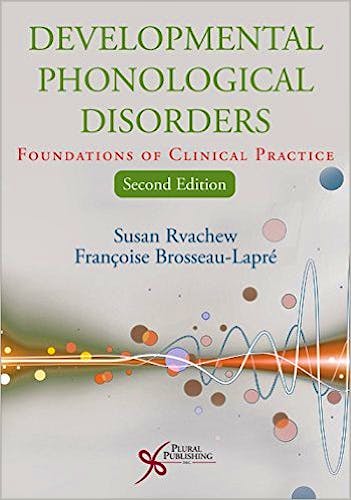

No hay productos en el carrito



Developmental Phonological Disorders. Foundations of Clinical Practice
Rvachew, S. — Brosseau-Lapré, F.
2ª Edición Diciembre 2016
Inglés
Tapa blanda
675 pags
1800 gr
17 x 24 x null cm
ISBN 9781597567176
Editorial Plural Publishing Inc
LIBRO IMPRESO
-5%
174,24 €165,53 €IVA incluido
167,54 €159,16 €IVA no incluido
Recíbelo en un plazo de
2 - 3 semanas
Description
Developmental Phonological Disorders: Foundations of Clinical Practice, Second Edition is the only graduate-level textbook designed for a competency-based approach to teaching, learning, and assessment. The book provides a deep review of theknowledge base necessary for the competent assessment, diagnosis, and treatment of developmental phonological disorders. Thoroughly revised and updated, the textbook contains learning objectives in each chapter to further support understanding of concepts and carefully designed case studies and demonstrations to promote application to clinical problem solving.
Key Features:
- Learning objectives for each chapter subsection
- Includes the "how, why, and when" to apply each assessment and treatment procedure in clinical practice
- 62 tables containing clinically relevant information such as normative data to interpret phonological assessment results
- 99 figures to support clinical decision making such as recommending a treatment delivery model, selecting treatment targets, or choosing evidence-based interventions
- 29 case studies to support a competency-based approach to teaching and assessment
- 33 demonstrations that show how to implement assessment and treatment procedures
The second edition provides a comprehensive overview of seminal studies and leading-edge research on both phonological development and phonological disorders, including motor speech disorders and emergent literacy. This wealth of theoreticalbackground is integrated with detailed descriptions and demonstrations of clinical practice, allowing the speech-language pathologist to design interventions that are adapted to the unique needs of each child while being consistent with the best researchevidence.
New to the Second Edition:
- Updated and expanded section on childhood apraxia of speech
- Updated and expanded sections on the identification and treatment of inconsistent phonological disorder
- Administration and interpretation of the Syllable Repetition Task added
- Administration and interpretation of the Diagnostic Evaluation of Articulation and Phonology added with case studies and demonstrations
- New organization, formatting, and editing to reduce the size of the book
- Case studies revised to a single-page format
- Improved Table of Contents to ease access to content, including norms tables, case studies, and demonstrations
Contents
Foreword
Preface
Acknowledgments
Part I. Phonology from a Developmental Perspective
Chapter 1. Describing Phonological Knowledge at Multiple Levels of Representation
1.1 Types of Phonological Knowledge
1.2 Describing Articulatory Knowledge
1.3 Describing Perceptual Knowledge
1.4 Describing Phonological Knowledge
1.5 References
Chapter 2. Speech Perception Development
2.1 Assessment of Speech Perception Skills in Infancy
2.2 Speech Perception Development in Infancy
2.3 Speech Perception Development in Childhood
2.4 Mechanisms That Underlie Speech Perception Development
2.5 References
Chapter 3. Development of Speech Motor Control
3.1 Acoustic and Kinematic Studies of Speech Development
3.2 Theories of Speech Motor Control
3.3 Factors That Contribute to the Development of Speech Motor Control
3.4 References
Chapter 4. Phonological Development
4.1 Normal Phonological Development
4.2 Emerging Phonological Knowledge in Infants and Toddlers
4.3 Normative Data: Preschool and School-Age Children
4.4 Theoretical Issues in Phonological Development
4.5 Environmental Influences and Physiological Constraints on Phonological Development
4.6 References
Part II. A Holistic Approach to Diagnosis and Treatment Planning
Chapter 5. Assessment of Children with Developmental Phonological Disorders
5.1 Planning the Assessment
5.2 Obligatory Assessment Tools and Procedures
5.3 Optional Assessment Tools and Procedures
5.4 Considerations for Dialect Speakers, Children Speaking English as a Second Language, and Multilingual Children
5.5 Putting It All Together
5.6 References
Chapter 6. Speech Sample Analysis
6.1 Analyses to Select Treatment Goals
6.2 Analyses to Track Treatment Progress
6.3 Predictive Assessment Procedures
6.4 References
Chapter 7. Nature of Developmental Phonological Disorders
7.1 Classification of Developmental Phonological Disorders
7.2 Linguistic Classification Systems
7.3 Shriberg's Framework for Research in Speech Sound Disorders
7.4 Psycholinguistic Approach to the Description of DPD
7.5 Prevalence, Comorbidity, and Long-Term Outcomes
7.6 References
Chapter 8. Treatment Planning
8.1 Deciding Whether to Provide an Intervention
8.2 Service Delivery Options
8.3 Treatment Planning for the Individual Child
8.4 References
Part III. Intervention at Multiple Levels of Representation
Chapter 9. Input-Oriented Intervention Procedures
9.1 Focused Stimulation
9.2 Ear Training
9.3 Dialogic Reading
9.4 Conclusions and Recommendations
9.5 References
Chapter 10. Output-Oriented Intervention Procedures
10.1 Explore Possibilities of the Vocal System
10.2 Controlled Variability in Babble and Early Words
10.3 Intelligible Speech
10.4 Ongoing Refinements Toward Adultlike Speech
10.5 Conclusions and Recommendations
10.6 References
Chapter 11. Phonological Intervention Procedures
11.1 Word-Based Phonology
11.2 Emergence and Reorganization of Phonological Structure
11.3 Explicit Access to Phonological Structure
11.4 Conclusions and Recommendations
11.5 References
List of Illustration Legends, Figures, Tables, Case Studies, and Demonstrations
Index
© 2025 Axón Librería S.L.
2.149.0